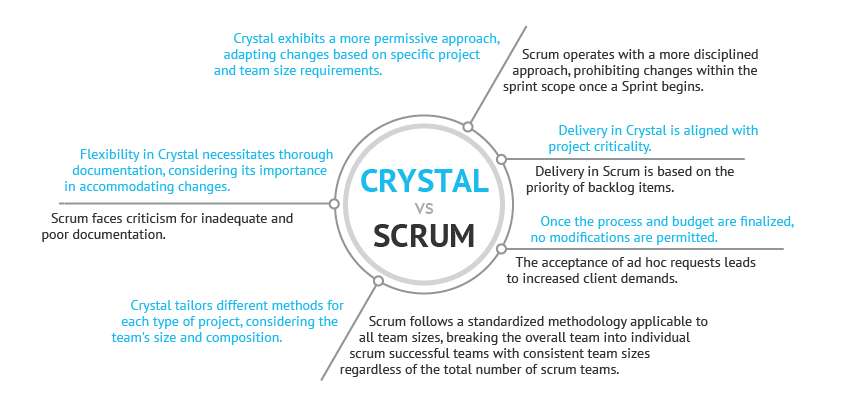Contents
Agile methodologies have transformed the landscape of software development, ushering in more flexible, collaborative and adaptive approaches to project management. Among the various Agile frameworks, Crystal Agile stands out as a nuanced and adaptable method tailored to specific project needs. In this comprehensive guide, we’ll delve into the essence of Crystal methods, exploring their key features, benefits, applications, challenges and comparisons with other Agile frameworks like Scrum.
Understanding Crystal Agile Methodology
Crystal methodology in Agile, often referred to as Crystal Clear Agile, is a family of methodologies developed by Alistair Cockburn. It embodies a set of key principles, practices, and processes that prioritize adaptability and simplicity in software development. Unlike rigid methodologies, Crystal in Agile acknowledges that every project is unique and requires a tailored approach.
Crystal Agile methodologies are particularly suitable for project types where adaptability, team collaboration and continuous improvement are essential. They advocate for pragmatic and adaptive approaches to software development, emphasizing the human elements and team dynamics while delivering valuable, high-quality software in an iterative and incremental manner.
Crystal Agile development emphasizes iterative processes, transparency, and collaboration to enhance software development.
What is Crystal Agile?
At its core, Crystal Framework emphasizes human interaction, community, skill and communication as primary success factors in software development. It encourages adapting the methodology based on the team size, complex projects and criticality, promoting the idea that a lighter approach often leads to better outcomes.
The Agile Crystal method integrates adaptable practices from Agile with Crystal’s focus on people, interactions, community values and talents. The Crystal family of Agile methodologies comprises multiple methodologies, each tailored to suit different project sizes, team sizes, project priorities and environments. They are named after colors, such as Crystal Clear, Crystal Yellow, Crystal Orange and so on, indicating different variations that cater to specific project needs.
Crystal Clear: Best suited for small teams of 1-6 people working on object-oriented projects where communication and collaboration are crucial. It emphasizes frequent delivery, close interaction among team members and simple processes.
Crystal Yellow: Intended for larger projects where team collaboration and communication are essential. It addresses moderate-sized projects with multiple teams and focuses on adapting processes for better coordination and efficiency.
Crystal Orange: Aimed at larger projects with additional complexities. It introduces more formalized processes while still emphasizing flexibility and adapting methodologies to specific project needs.
Crystal Red: Tailored for larger-scale projects with significant complexity and risks. It involves more structure and discipline while maintaining the core values of flexibility and adaptability.
Crystal Agile Methodology: Key Features and Components
The term “Crystal Agile” encapsulates the synergy between Agile methodologies and the clarity and precision exemplified by Crystal methodologies. The key features of Crystal Agile lie in its flexibility, focusing on delivering high-quality software incrementally while constantly adapting to changing requirements. It includes Agile principles such as frequent delivery, reflective improvement, close communication, simplicity and teamwork.
Roles
- Real roles refer to the tangible and specific responsibilities that individuals undertake within a project. These roles are more traditional and task-oriented.
- Examples include Developer/Programmer, Designer/Architect, Tester/QA Specialist, Sponsor/Customer, Manager/Coordinator, User/End-User Representative, etc.
- Real roles involve active participation in project activities, such as coding, testing, designing, managing or representing the stakeholders’ interests.
- Virtual roles refer to responsibilities or tasks temporarily assumed by team members based on the project’s needs. These roles are more fluid and adaptable.
- In Crystal methodologies, virtual roles may arise as team members dynamically take on additional tasks or responsibilities that may not fall under their traditional role definitions.
- For example, a Developer might temporarily take on the responsibility of conducting user interviews (usually handled by a User/End-User Representative) due to scheduling conflicts or resource constraints.
- Virtual roles allow for flexibility and agility within the team, enabling members to adapt to changing project demands and support each other as needed.
Represents the stakeholders and end-users, providing project goals, priorities and requirements. They ensure the developed software aligns with the business needs.
Team members responsible for writing code, testing software functionalities and delivering working features. They actively contribute to the software development process.
Individuals who design the software architecture, ensuring it meets functional requirements and aligns with the project’s goals. They focus on system design, scalability and maintainability.
Plays a supportive role in overseeing the project, facilitating communication, removing obstacles and ensuring the team functions smoothly. This role may involve more facilitation than direct management.
Responsible for ensuring software quality by testing functionalities, identifying defects and working closely with developers to rectify issues. They also ensure the software meets specified quality standards.
Represents the real users’ perspective, provides feedback and clarifies requirements. They play a vital role in ensuring the developed functionalities align with users’ needs.
In some cases, a role focused on guiding the team in adopting Crystal methodologies, improving processes and facilitating continuous learning and improvement.
Policy Standards
Incremental delivery regularly
Tracking progress through milestones by relying on software deliveries and pivotal decisions rather than solely on written documentation.
Direct user involvement
Automated regression testing of functionality
Two user viewings per release (This, in turn, means at least two real users will be checking the released function to avoid any mistakes.)
Workshops aimed at fine-tuning both product and methodology are scheduled at the start and midpoint of each increment
When to Use the Crystal Agile Method
The Crystal Agile Method is best suited for projects that require flexibility, adaptability and a strong emphasis on human interactions. Unlike rigid frameworks, Crystal prioritizes communication, collaboration and continuous improvement, making it ideal for small to medium-sized teams working on projects with evolving requirements. This methodology is particularly effective when:
- Frequent face-to-face communication is possible, as it relies on transparency and direct feedback loops
- Projects require adaptability to changing business needs, making a lightweight, iterative approach more effective
- Team size is manageable (typically up to 10-20 members), ensuring that communication remains seamless
- Minimal documentation is preferred to avoid unnecessary overhead while maintaining project momentum
- A strong trust-based culture exists, allowing teams to self-organize and take ownership of their work
- Rapid delivery cycles are required, enabling continuous releases and quick customer feedback integration
However, the Crystal method is less suitable for large-scale, highly regulated environments where strict compliance, heavy documentation and formalized governance are necessary.
Benefits of Crystal Agile
The Crystal Agile methodology is characterized by its emphasis on people, collaboration, flexibility and adaptability in software development. Unlike many other methodologies, Crystal does not enforce a rigid set of rules but provides guiding principles that can be adapted based on the unique context of each project. Here are the key features and components of the Crystal Agile methodology:
- Team-Centric Approach: Crystal Agile prioritizes the people involved in the project. It values their skills, interactions, and collaboration, considering these factors as crucial to project success.
- Multiple Methodologies (Crystal Colors): Crystal is not a one-size-fits-all methodology. It offers different variants or “colors” as mentioned before (e.g., Crystal Clear, Crystal Yellow, Crystal Orange, Crystal Maroon) tailored for specific project characteristics such as team size, level of criticality and priorities.
- Flexibility and Adaptability: It emphasizes adapting practices to fit the context of the project. Crystal Agile recognizes that different projects have varying needs and constraints and encourages software development teams to adjust their processes accordingly.
- Incremental and Iterative Development: Similar to other agile methodologies, Crystal promotes iterative development and incremental delivery of software. This allows for frequent feedback, early detection of issues and adaptability to changing requirements.
- Communication and Collaboration: Crystal Agile places a strong emphasis on effective communication and collaboration among team members, stakeholders and customers. It encourages face-to-face interactions and open communication channels.
- Continuous Improvement: Reflective practices are integral to Crystal’s methodologies. Teams are encouraged to regularly assess their processes, identify areas for improvement and make necessary adjustments to enhance performance.
- Risk Management: Crystal methodologies focus on managing risks inherent in software development. By addressing risks early and continuously, teams can mitigate potential issues that may arise during the project life cycle.
- Priority-Based Delivery: Prioritizing high-value features and functionalities is a key aspect of Crystal Agile. This allows teams to deliver the most critical elements first, ensuring that the project’s most important needs are met early.
- Empirical Process Control: Crystal methodologies often employ empirical process control, relying on real-time feedback and data-driven decision-making to adapt and improve throughout the project.
- Leadership and Self-Organization: Crystal methodologies encourage leadership within teams and foster an environment where team members can self-organize to accomplish tasks effectively.
Crystal Agile in Action
Implementing Crystal Agile involves tailoring the methodology to suit the specific needs and dynamics of the project team. It encourages continuous reflection and adjustment based on feedback, allowing for a more responsive and efficient development process.
Tailoring Crystal Agile for Your Team
Adopting Crystal Agile involves customizing its practices to align with your team’s strengths, weaknesses, and project requirements. Tailoring the methodology allows for optimal utilization of resources and maximizes the chances of project success.
Real-World Case Studies
Crystal Clear Agile methodology is showcased through the creation of IBM’s Orange platform. This platform was designed with the purpose of aiding companies in upholding compliance and security standards across their array of technological devices, including servers, desktops, laptops and mobile devices. Cockburn formulated this flexible approach as a response to the pressing demand for rapid product delivery, emphasizing the importance of close-knit communication and the iterative cycle of frequent testing, feedback and refinement.
This methodology is particularly well-suited for app development involving smaller teams. The practice of continual testing and active user engagement serves as a means to swiftly detect and address errors in the early stages of development. This not only contributes to cost savings but also accelerates the overall delivery timeline. Furthermore, fostering an environment of close, osmotic communication proves to be integral to the success of this development process.
At Google, several sectors are betting on Agile software development methodologies such as Scrum, creating and testing services and products. Each development team chooses the technology and method that can best be applied to solve problems.
Crystal Agile Metrics for Success
Measuring success in Crystal Agile involves tracking key performance indicators (KPIs) aligned with the methodology’s core principles. KPIs may include metrics related to project velocity, team satisfaction, defect density and customer feedback.
Key Performance Indicators (KPIs)
In the context of Crystal Agile methodology, Key Performance Indicators (KPIs) are vital metrics used to gauge project success. These indicators include Project Velocity (speed of product delivery), Team Satisfaction, Defect Density (code quality), Customer Feedback, Cycle Time (task completion duration) and Burnup/Burndown Charts. Tracking these KPIs allows agile teams to assess progress, identify areas for improvement and make informed decisions for continual optimization throughout the project lifecycle.
Overcoming Common Challenges
While Crystal Agile offers numerous benefits, challenges such as resistance to change, unclear project vision or lack of expertise may arise. Addressing these challenges involves fostering a culture of adaptability, continuous learning and effective leadership.
Crystal Agile vs. Other Agile Frameworks
Crystal Agile framework distinguishes itself from other Agile frameworks by prioritizing adaptability and tailoring its approach based on project and team specifics, particularly emphasizing team size and flexibility in accommodating changes. Other Agile frameworks, such as Scrum, Kanban and XP, follow more standardized methodologies with varying levels of flexibility and prescribed practices, often focusing on specific rules, predefined processes and backlog priorities for project execution.
Crystal Agile vs. Scrum
Crystal Agile and Scrum share some common principles, but they diverge in their level of prescription and flexibility. While Scrum provides more structured roles and practices, Crystal Agile offers greater adaptability and customization.
Crystal vs Scrum
Conclusion
Crystal Agile methodology offers a tailored, adaptable approach to software development, prioritizing simplicity, collaboration and flexibility. Its effectiveness lies in its ability to be customized for various project contexts, fostering an environment conducive to continuous improvement and successful outcomes.
Ready to transform your software development process with flexibility and tailored Agile approaches? Embrace the power of Crystal Agile methodologies today with DevCom. Let’s embark on a journey to elevate your software development project to new heights — get in touch with us now!







